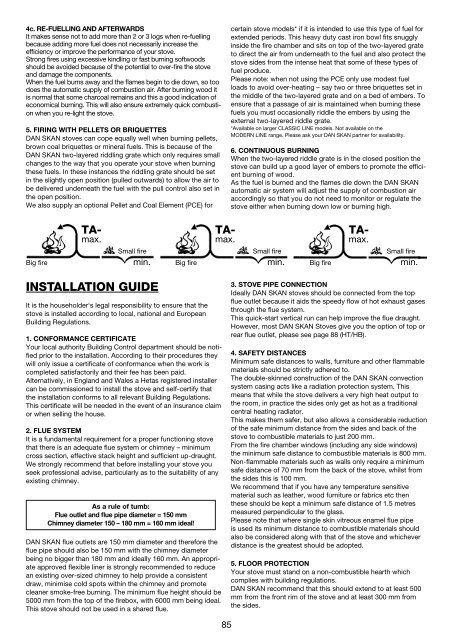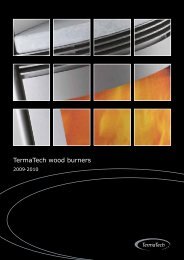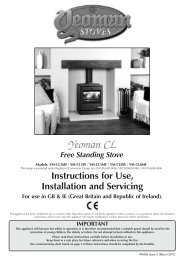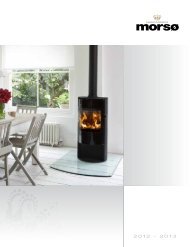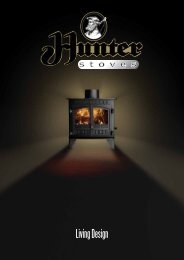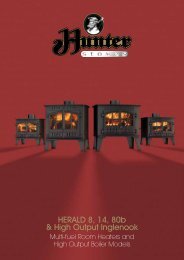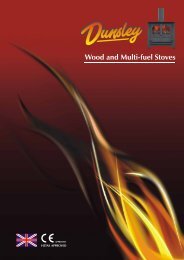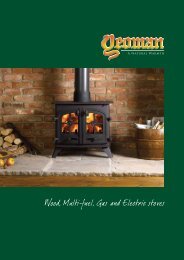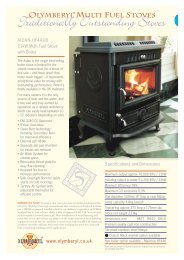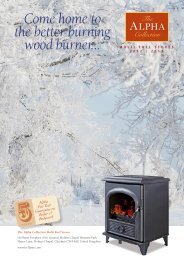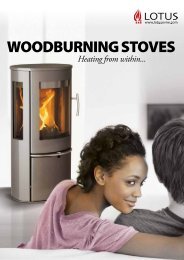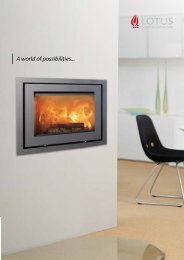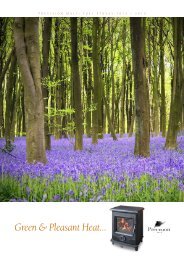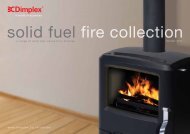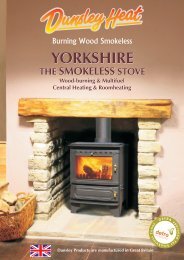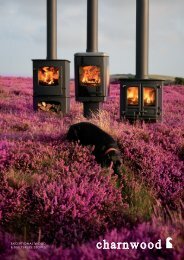You also want an ePaper? Increase the reach of your titles
YUMPU automatically turns print PDFs into web optimized ePapers that Google loves.
4c. RE-FUELLING AND AFTERWARDS<br />
it makes sense not to add more than 2 or 3 logs when re-fuelling<br />
because adding more fuel does not necessarily increase the<br />
efficiency or improve the performance of your stove.<br />
Strong fires using excessive kindling or fast burning softwoods<br />
should be avoided because of the potential to over-fire the stove<br />
and damage the components.<br />
When the fuel burns away and the flames begin to die down, so too<br />
does the automatic supply of combustion air. after burning wood it<br />
is normal that some charcoal remains and this a good indication of<br />
economical burning. This will also ensure extremely quick combustion<br />
when you re-light the stove.<br />
5. FIRING WITH PELLETS OR BRIQUETTES<br />
Dan SKan stoves can cope equally well when burning pellets,<br />
brown coal briquettes or mineral fuels. This is because of the<br />
Dan SKan two-layered riddling grate which only requires small<br />
changes to the way that you operate your stove when burning<br />
these fuels. in these instances the riddling grate should be set<br />
in the slightly open position (pulled outwards) to allow the air to<br />
be delivered underneath the fuel with the pull control also set in<br />
the open position.<br />
We also supply an optional Pellet and Coal Element (PCE) for<br />
Big fire<br />
TAmax.<br />
INSTALLATION <strong>GUIDE</strong><br />
it is the householder‘s legal responsibility to ensure that the<br />
stove is installed according to local, national and European<br />
Building regulations.<br />
1. CONFORMANCE CERTIFICATE<br />
Your local authority Building Control department should be notified<br />
prior to the installation. according to their procedures they<br />
will only issue a certificate of conformance when the work is<br />
completed satisfactorily and their fee has been paid.<br />
alternatively, in England and Wales a Hetas registered installer<br />
can be commissioned to install the stove and self-certify that<br />
the installation conforms to all relevant Building regulations.<br />
This certificate will be needed in the event of an insurance claim<br />
or when selling the house.<br />
2. FLUE SYSTEM<br />
it is a fundamental requirement for a proper functioning stove<br />
that there is an adequate flue system or chimney – minimum<br />
cross section, effective stack height and sufficient up-draught.<br />
We strongly recommend that before installing your stove you<br />
seek professional advise, particularly as to the suitability of any<br />
existing chimney.<br />
Dan SKan flue outlets are 150 mm diameter and therefore the<br />
flue pipe should also be 150 mm with the chimney diameter<br />
being no bigger than 180 mm and ideally 160 mm. an appropriate<br />
approved flexible liner is strongly recommended to reduce<br />
an existing over-sized chimney to help provide a consistent<br />
draw, minimise cold spots within the chimney and promote<br />
cleaner smoke-free burning. <strong>The</strong> minimum flue height should be<br />
5000 mm from the top of the firebox, with 6000 mm being ideal.<br />
This stove should not be used in a shared flue.<br />
TAmax.<br />
85<br />
certain stove models* if it is intended to use this type of fuel for<br />
extended periods. This heavy duty cast iron bowl fits snuggly<br />
inside the fire chamber and sits on top of the two-layered grate<br />
to direct the air from underneath to the fuel and also protect the<br />
stove sides from the intense heat that some of these types of<br />
fuel produce.<br />
Please note: when not using the PCE only use modest fuel<br />
loads to avoid over-heating – say two or three briquettes set in<br />
the middle of the two-layered grate and on a bed of embers. To<br />
ensure that a passage of air is maintained when burning these<br />
fuels you must occasionally riddle the embers by using the<br />
external two-layered riddle grate.<br />
*available on larger ClaSSiC linE models. not available on the<br />
MODErn linE range. Please ask your Dan SKan partner for availability.<br />
6. CONTINUOUS BURNING<br />
When the two-layered riddle grate is in the closed position the<br />
stove can build up a good layer of embers to promote the efficient<br />
burning of wood.<br />
as the fuel is burned and the flames die down the Dan SKan<br />
automatic air system will adjust the supply of combustion air<br />
accordingly so that you do not need to monitor or regulate the<br />
stove either when burning down low or burning high.<br />
TAmax.<br />
Small fire Small fire Small fire<br />
Big fire Big fire<br />
min.<br />
As a rule of tumb:<br />
Flue outlet and flue pipe diameter = 150 mm<br />
Chimney diameter 150 – 180 mm = 160 mm ideal!<br />
min.<br />
min.<br />
3. <strong>STOVE</strong> PIPE CONNECTION<br />
ideally Dan SKan stoves should be connected from the top<br />
flue outlet because it aids the speedy flow of hot exhaust gases<br />
through the flue system.<br />
This quick-start vertical run can help improve the flue draught.<br />
However, most Dan SKan <strong>Stove</strong>s give you the option of top or<br />
rear flue outlet, please see page 88 (HT/HB).<br />
4. SAFETY DISTANCES<br />
Minimum safe distances to walls, furniture and other flammable<br />
materials should be strictly adhered to.<br />
<strong>The</strong> double-skinned construction of the Dan SKan convection<br />
system casing acts like a radiation protection system. This<br />
means that while the stove delivers a very high heat output to<br />
the room, in practice the sides only get as hot as a traditional<br />
central heating radiator.<br />
This makes them safer, but also allows a considerable reduction<br />
of the safe minimum distance from the sides and back of the<br />
stove to combustible materials to just 200 mm.<br />
From the fire chamber windows (including any side windows)<br />
the minimum safe distance to combustible materials is 800 mm.<br />
non-flammable materials such as walls only require a minimum<br />
safe distance of 70 mm from the back of the stove, whilst from<br />
the sides this is 100 mm.<br />
We recommend that if you have any temperature sensitive<br />
material such as leather, wood furniture or fabrics etc then<br />
these should be kept a minimum safe distance of 1.5 metres<br />
measured perpendicular to the glass.<br />
Please note that where single skin vitreous enamel flue pipe<br />
is used its minimum distance to combustible materials should<br />
also be considered along with that of the stove and whichever<br />
distance is the greatest should be adopted.<br />
5. FLOOR PROTECTION<br />
Your stove must stand on a non-combustible hearth which<br />
complies with building regulations.<br />
Dan SKan recommend that this should extend to at least 500<br />
mm from the front rim of the stove and at least 300 mm from<br />
the sides.


